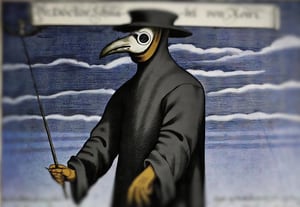I’m a conservation biologist who studies emerging infectious diseases. When people ask me what I think the next pandemic will be, I often say we are in the middle of a pandemic.; It just affects more species than us humans.
I’m referring to the highly pathogenic avian influenza H5N1 strain (HPAI H5N1), also known as avian influenza, has killed millions of birds and an unknown number of mammals, particularly in the past three years.

The virus emerged in domestic geese in China in 1997 and quickly spread to humans in Southeast Asia, with a mortality rate of approximately 40-50%. My research team discovered the virus in 2005 when a mammal, an endangered civet, was killed in a captive breeding program in Cuc Phuong National Park in Vietnam.
It has never been proven how the animals became infected with avian influenza. Their diet consists mainly of earthworms, so they don’t become infected like many captive tigers in the area by eating diseased birds.
This finding prompted us to collect all confirmed reports of fatal avian influenza infections to assess how much of a threat this virus might pose to wildlife.
That’s why a newly discovered virus in Chinese poultry threatens much of the world’s biodiversity.
Until December 2005, most confirmed cases of infection were found in a number of zoos and rescue centers in Thailand and Cambodia. Our 2006 analysis showed that almost half (48%) of all different bird groups (called “order” by taxonomists) It contains a species in which fatal bird flu infections have been reported. These 13 orders account for 84% of all birds.
Twenty years ago, we theorized that circulating H5N1 strains were likely to be highly pathogenic to all birds. We also show that the list of confirmed infected species includes those that are globally threatened and that critical habitats such as the Mekong Delta in Vietnam are close to reported poultry outbreaks.
Mammals known to be susceptible to avian influenza in the early 2000s include primates, rodents, pigs and rabbits. Large carnivores such as Bengal tigers and clouded leopards were reportedly killed, as well as domestic cats.
Our 2006 paper showed how easily the virus could cross the species barrier and spread suggesting it could one day pose a pandemic-sized threat to global biodiversity.
Unfortunately, our warning was correct.

Two decades later, bird flu is killing species arctic highlands until Antarctica continent .
In recent years, avian influenza has spread rapidly in Europe and penetrated into North and South America, killing millions of poultry and a variety of birds and mammals. A recent article found 2Six countries have reported at least 48 mammal species dying from the virus since 2020, when the latest reported infections began to surge.
Even the ocean is not safe. Thirteen species of aquatic mammals have died since 2020, including sea lions, porpoises and American dolphins, often in the thousands in South America. Currently, a variety of terrestrial scavengers and predatory mammals have also been shown to be susceptible, including cougars, lynxes, brown bears, black bears, and polar bears.
The UK alone has lost more than 75% of its great skua population, and the number of northern gannets has also declined by 25%. Recent declines in sandwich terns (35%) and common terns (42%) are also largely caused by viruses.
Scientists have not yet been able to fully sequence the virus in all affected species. Continued research and monitoring can tell us how adaptable it ultimately is, and whether it can jump to more species. We know it can already infect humans: one or more genetic mutations can make it more contagious.
From January 1, 2003 to December 21, 2023, There were 882 cases of human infection with H5N1 virus in 23 countries, including 461 (52%) deaths .
More than half of these deaths occurred in Vietnam, China, Cambodia and Laos. The first case of poultry-to-human transmission was recorded in Cambodia in December 2003. Intermittent cases were reported until 2014, followed by a hiatus until 2023, resulting in 41 deaths among 64 cases. The H5N1 virus subtype has been detected in poultry in Cambodia since 2014. The circulating H5N1 virus in the early 2000s had high human mortality rates, so it is concerning that we are now starting to see people die again from exposure to poultry. .
It’s not just H5 subtype avian influenza that worries humans. The H10N1 virus was originally isolated from wild birds in South Korea, but has also been reported in samples from China and Mongolia.
Recent studies have found that these specific viral subtypes can be transmitted to humans after being found to be pathogenic in laboratory mice and ferrets. The first patient diagnosed with H10N5 infection died in China on January 27, 2024, but the patient also suffered from seasonal influenza (H3N2). They had been exposed to live poultry, which also tested positive for H10N5.

Some of the species killed by bird flu in the past three years are already at risk of extinction. The first death of a skua on the Antarctic continent due to the virus highlights the looming threat to penguin colonies where skuas feed on their eggs and chicks. Humboldt penguins have die from virus In Chile.
How can we stop this tsunami of H5N1 and other avian influenzas? A comprehensive review of poultry production worldwide. Make farms self-sufficient in raising eggs and chicks rather than exporting internationally. The trend towards large farms with over a million birds needs to stop.
To avoid the worst consequences of this virus, we must examine its main source: incubators on intensive poultry farms.
*Diana Bell, Professor of Conservation Biology, University of East Anglia
